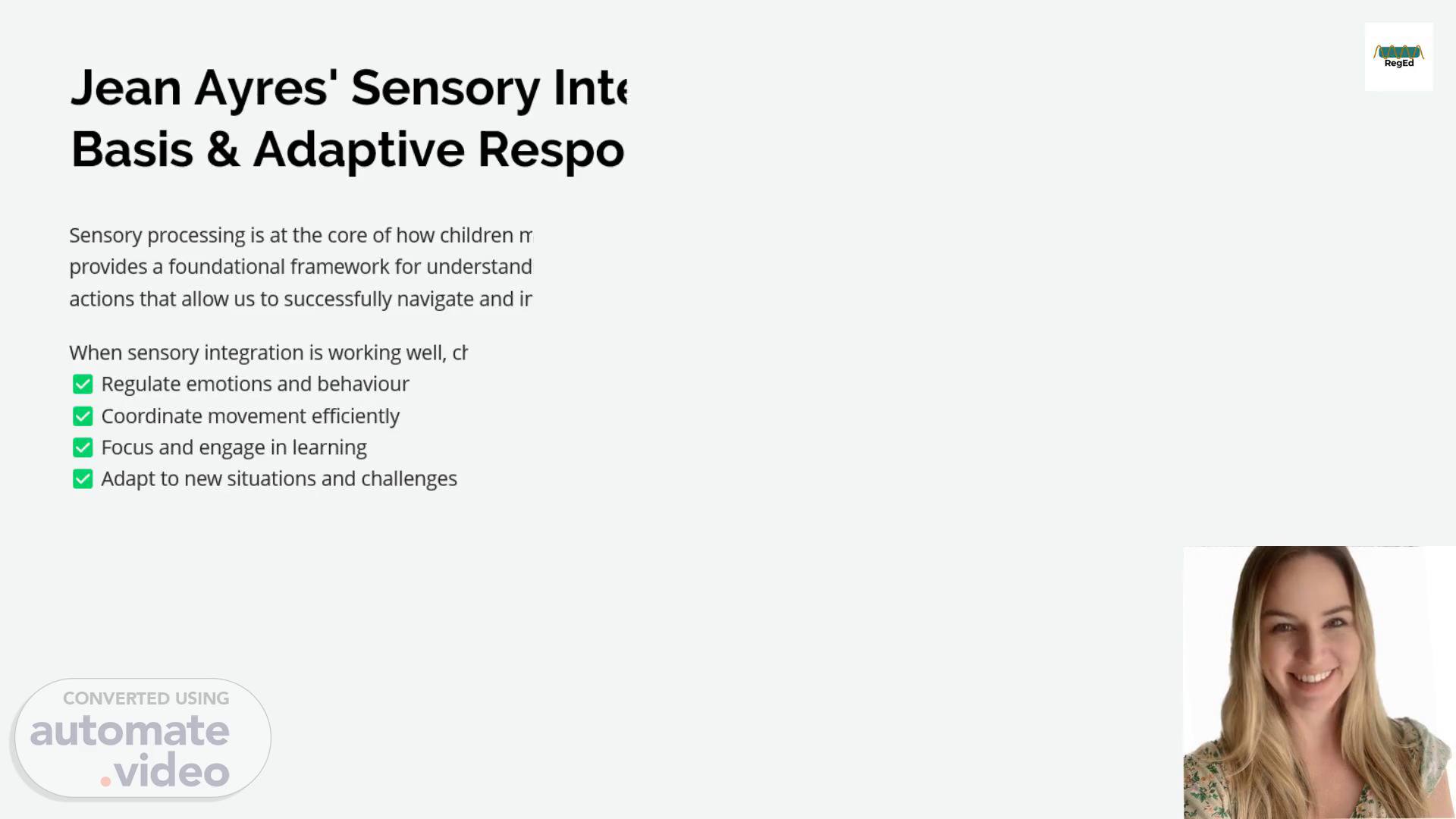Scene 1 (0s)
Jean Ayres' Sensory Integration (ASI) – Neurological Basis & Adaptive Response.
Scene 2 (49s)
[Audio] The nervous system takes in information from all eight sensory systems and sorts it into meaningful experiences. This foundation of sensory input sets the stage for the brain's subconscious processing of sensory data. As we receive sensory input, our brain decides what to focus on, ignore, or act upon. This decision-making process allows us to prioritize and filter out irrelevant information, enabling us to respond effectively to our environment. When sensory input is well-integrated, adaptive responses occur, permitting children to regulate their emotions, coordinate their movements, and engage in learning. However, when sensory integration is disrupted, difficulties in processing sensory input can impact motor planning, attention, social participation, and self-regulation..
Scene 3 (1m 39s)
[Audio] The brain consists of distinct regions, each contributing significantly to sensory integration. The Cortex is accountable for advanced processing and learning, whereas the Limbic System facilitates emotional regulation and connects sensory experiences. The Thalamus serves as a sensory relay station, transmitting and receiving signals among diverse brain areas. Simultaneously, the Brainstem manages fundamental processing, guaranteeing essential functions such as respiration and cardiac rhythm remain stable. Sensory integration transcends individual senses; it is about how these various brain regions collaborate to produce adaptive responses, enabling us to navigate and interact with our surroundings..
Scene 4 (2m 25s)
[Audio] The limbic system plays a crucial role in sensory processing by linking sensory experiences with emotions. When sensory input is perceived as unsafe, the brain responds with fight, flight, or freeze reactions. This highlights the significance of sensory integration in emotional regulation, as mismatches between sensory input and expectations can lead to meltdowns, shutdowns, or sensory-seeking behaviors. Furthermore, the cortex, particularly the parietal lobe, is responsible for spatial awareness, motor coordination, and body awareness, while the prefrontal cortex governs executive function, including attention, problem-solving, and self-regulation. However, when sensory input is disorganized at lower levels, the cortex faces challenges in maintaining attention, planning actions, and regulating behavior..
Scene 5 (3m 17s)
[Audio] An adaptive response is the ability to react appropriately to sensory input and environmental demands. This means that when we receive sensory information, such as sights, sounds, or textures, our brain processes this information and generates a response that is suitable for the situation. For instance, if we're holding a pencil, our brain receives sensory input from our hands and fingers, processes this information, and produces a response - adjusting our grip to grasp the pencil correctly. Similarly, if we're balancing on one foot, our brain receives sensory input from our body position and movements, processes this information, and generates a response - making adjustments to maintain equilibrium. In both instances, our brain adapts to the environmental demands, enabling us to successfully interact with our surroundings..
Scene 6 (4m 9s)
[Audio] Adaptive responses manifest in everyday activities, demonstrating how children successfully generate these responses. When children can do so, they become better equipped to participate in learning, social interactions, and daily tasks. Moreover, adaptive responses extend beyond physical actions, incorporating emotional regulation, attention, and social engagement as well..
Scene 7 (4m 42s)
[Audio] A well-integrated sensory system allows children to filter distractions and focus on learning. In contrast, sensory mismatches can cause inattention, fidgeting, or zoning out. When sensory input is well-integrated, children can effectively manage frustration, transitions, and challenges. However, sensory processing differences may lead to meltdowns, withdrawal, or anxiety. Fine motor skills such as writing and cutting, as well as gross motor skills like jumping and balancing, heavily depend on strong sensory integration. Challenges in motor planning, including dyspraxia, may arise from inefficient sensory processing. Sensory integration also plays a crucial role in helping children understand social cues, body language, and spatial awareness, ultimately enabling social participation and communication..
Scene 8 (5m 33s)
[Audio] Brain-based function is crucial because sensory integration affects movement, attention, and emotional regulation. Sensory integration is responsible for helping children navigate and interact with their environment. However, when sensory processing is mismatched, students may struggle with focus, self-regulation, and motor coordination. It is essential to recognize this and provide environments where children can thrive, rather than trying to fix them. Instead, we should focus on understanding their needs and adapting our approach accordingly..
Scene 9 (6m 8s)
[Audio] In the next lesson, we will examine what to look for in students, identify sensory strengths, and support sensory needs through practical classroom strategies. We will explore how sensory processing differences manifest in students, and how recognizing these differences can inform our teaching practices. By doing so, we will create a more inclusive and responsive learning environment, tailored to meet the diverse needs of our students..
Scene 10 (6m 34s)
[Audio] Every student's sensory experience is unique, and understanding how to support them creates more inclusive, accessible learning environments. By recognizing the neurological basis of sensory processing and its impact on adaptive responses, educators can better understand the underlying factors that influence student behavior, attention, and learning. This knowledge forms the foundation for creating sensory-supportive classrooms where all students can thrive..
